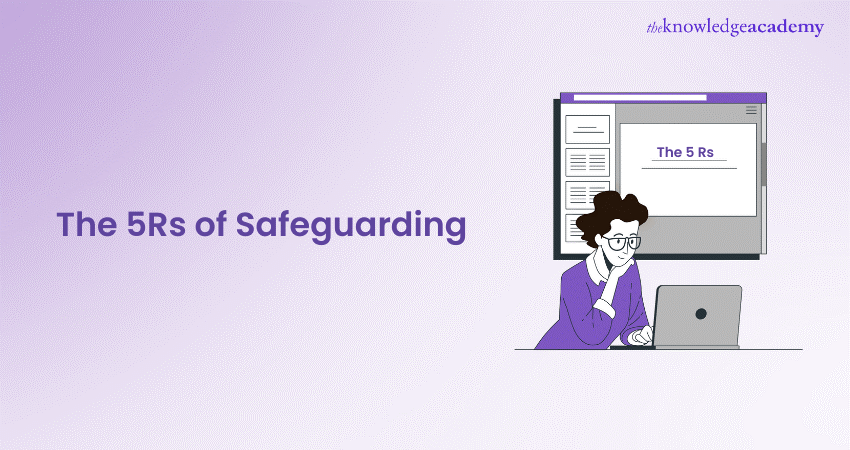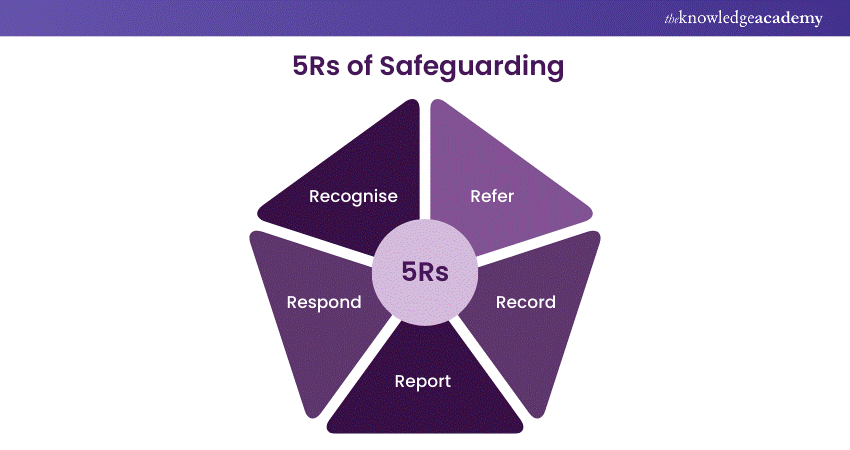We may not have the course you’re looking for. If you enquire or give us a call on +1800812339 and speak to our training experts, we may still be able to help with your training requirements.
Training Outcomes Within Your Budget!
We ensure quality, budget-alignment, and timely delivery by our expert instructors.

Safeguarding is a cornerstone in ensuring the protection and well-being of vulnerable individuals, especially children and adults facing heightened risks. At the heart of this protective framework lie the "5Rs" – Recognise, Respond, Report, Record, and Refer. These principles guide individuals, professionals, and communities through a systematic process aimed at creating safe environments, responding to concerns, and ultimately mastering the art of ensuring safety for those who need it the most.
The 5Rs of Safeguarding are crucial principles and actions, especially for vulnerable populations, such as at-risk children or adults. Explore the 5Rs of Safeguarding - Recognise, Respond, Report, Record, and Refer. Read this blog to master the art of ensuring safety for vulnerable individuals in diverse situations.
Table of Contents
1) What is the meaning of Safeguarding children and vulnerable adults?
2) What are the 5Rs of Safeguarding?
a) Recognise
b) Respond
c) Report
d) Record
e) Refer
3) What is the reason behind referring to these principles as the 4 Rs of Safeguarding?
4) Conclusion
What is the meaning of Safeguarding children and vulnerable adults?
Safeguarding children and vulnerable adults refer to the process of protecting individuals who may be at risk of harm, abuse, or exploitation due to their age, disability, or other factors that make them particularly vulnerable. This concept is rooted in recognising the need to ensure the well-being and safety of those who cannot protect themselves adequately.
In the context of children, Safeguarding involves creating an environment that promotes their welfare and protects them from maltreatment. This can include various forms of abuse, such as physical, emotional, or sexual abuse, as well as neglect. The aim is to provide a secure and nurturing environment that allows children to grow and develop in a healthy and safe manner.
Vulnerable adults, on the other hand, may include individuals who are elderly, disabled, or otherwise unable to protect themselves from harm or exploitation. Safeguarding in this context involves measures to prevent abuse, neglect, or exploitation and to ensure that vulnerable adults receive the support and care they need to maintain their well-being and dignity.
Key components of Safeguarding include:
a) Prevention
b) Protection
c) Partnership
d) Empowerment
e) Accountability
What are the 5Rs of Safeguarding?
Listed below are the 5Rs of Safeguarding.

1) Recognise
Recognition is the first crucial step in Safeguarding. It involves being able to identify signs and indicators of potential harm, abuse, or neglect. Professionals and individuals involved in the care of children or vulnerable adults must be trained to recognise various forms of abuse, whether it's physical, emotional, sexual, or neglect.
Recognising signs may involve observing changes in behaviour, physical appearance, or communication patterns. Training and awareness campaigns are essential to ensure that those in contact with at-risk individuals can identify potential risks and act promptly.
2) Respond
Once signs of harm or abuse are recognised, the next step is to respond appropriately. Responding involves taking immediate action to ensure the safety and well-being of the individual at risk. This might include providing support, removing the person from a harmful situation, or contacting relevant authorities and professionals. The response should be tailored to the specific situation and the needs of the individual, with a focus on minimising further harm and promoting their welfare.
Empower your role as a Safeguarding Officer with our Safeguarding Officer Masterclass. Join now!
3) Report
Reporting is a critical aspect of Safeguarding. Professionals, caregivers, and individuals who suspect or witness abuse must report their concerns to the appropriate authorities. This may involve contacting local Safeguarding teams, social services, or the police, depending on the severity and nature of the situation.
Timely and accurate reporting ensures that intervention can occur swiftly, potentially preventing further harm. It is essential to follow established reporting procedures and guidelines to ensure that information is communicated effectively and reaches the appropriate channels.
4) Record
Recording information is vital for maintaining a clear and comprehensive account of Safeguarding concerns and actions taken. Professionals involved in the care of children or vulnerable adults should keep detailed records of their observations, assessments, and any steps taken in response to Safeguarding concerns.
Accurate and well-maintained records not only contribute to the effective management of individual cases but also serve as crucial documentation in any subsequent investigations or legal proceedings. Privacy and confidentiality must be maintained while adhering to relevant data protection laws and policies.
5) Refer
Referring involves making appropriate arrangements for further support, investigation, or intervention by referring the case to relevant agencies or professionals. This step ensures that the necessary expertise and resources are brought in to address the safeguarding concerns effectively.
Referrals may be made to social services, health professionals, law enforcement, or other appropriate organisations, depending on the nature and severity of the issues identified. Clear communication and collaboration are key to facilitating a seamless transition between the reporting and referral stages of the safeguarding process.
Elevate workplace safety with our courses on Helath and Safety Courses – Join now for a secure and compliant working environment!
What is the reason behind referring to these principles as the 4 Rs of Safeguarding?
The terminology surrounding Safeguarding principles can vary among organisations, leading to distinctions like the 'five Rs' or the 'four Rs.' While the core principles of Recognise, Respond, Report, Record, and Refer remain constant, variations arise in the naming convention. Some organisations combine 'Report' and 'Refer' into a single principle, resulting in the 'four Rs.'
Alternatively, the exclusion of 'Respond' may lead to the use of 'four Rs.' Despite the nomenclature differences, these variations underscore a shared commitment to Safeguarding vulnerable individuals and maintaining their well-being
Conclusion
In conclusion, the '5Rs of Safeguarding'—Recognise, Respond, Report, Record, and Refer—form a comprehensive framework essential for protecting vulnerable individuals. Despite some organisations adopting the term 'four Rs' due to variations in naming conventions, the core principles remain steadfast. The commitment to creating safe environments and ensuring the well-being of children and vulnerable adults underscores the collective responsibility embedded in these Safeguarding principles.
Empower your workplace leaders with essential Health and Safety Training for Managers and Supervisors. Sign up now for a safer and compliant working environment!
Frequently Asked Questions
Upcoming Health & Safety Resources Batches & Dates
Date
 Safeguarding Officer Training
Safeguarding Officer Training
Fri 3rd Jan 2025
Fri 28th Mar 2025
Fri 23rd May 2025
Fri 4th Jul 2025
Fri 5th Sep 2025
Fri 24th Oct 2025
Fri 5th Dec 2025







 Top Rated Course
Top Rated Course



 If you wish to make any changes to your course, please
If you wish to make any changes to your course, please


